I'm building an Android application using ListView. I have list view items as show below.

^ List Item Index 0

^ List Item Index 1
The xlm is as follows.
<?xml version="1.0" encoding="utf-8"?>
<LinearLayout xmlns:android="http://schemas.android.com/apk/res/android"
android:layout_width="fill_parent"
android:layout_height="wrap_content"
android:orientation="horizontal"
android:padding="4dip" >
<ImageView
android:id="@+id/icon"
android:layout_width="wrap_content"
android:layout_height="fill_parent"
android:src="@drawable/icon" />
<LinearLayout
android:layout_width="wrap_content"
android:layout_height="fill_parent"
android:layout_weight="0.93"
android:orientation="vertical"
android:padding="10dp"
android:paddingLeft="10dp"
android:paddingRight="10dp" >
<!-- JFN bottom used to be 2, top 6 -->
<!-- Name Label -->
<TextView
android:id="@+id/name"
android:layout_width="fill_parent"
android:layout_height="wrap_content"
android:paddingBottom="0dip"
android:paddingTop="0dip"
android:textColor="#43bd00"
android:textSize="16sp"
android:textStyle="bold" />
<!-- Email label -->
<TextView
android:id="@+id/email"
android:layout_width="fill_parent"
android:layout_height="wrap_content"
android:paddingBottom="0dip"
android:textColor="#acacac" />
<!-- Mobile number label -->
<TextView
android:id="@+id/mobile"
android:layout_width="wrap_content"
android:layout_height="wrap_content"
android:gravity="left"
android:text="Mobile: "
android:textColor="#5d5d5d"
android:textStyle="bold" />
</LinearLayout>
<LinearLayout
android:layout_width="wrap_content"
android:layout_height="wrap_content"
android:gravity="right"
android:orientation="vertical" >
<ImageView
android:id="@+id/chat"
android:layout_width="wrap_content"
android:layout_height="fill_parent"
android:layout_marginRight="2dip"
android:gravity="right"
android:src="@drawable/chat" />
<ImageView
android:id="@+id/calendar"
android:layout_width="wrap_content"
android:layout_height="fill_parent"
android:layout_marginRight="2dip"
android:gravity="right"
android:src="@drawable/calendar" />
</LinearLayout>
</LinearLayout>
I'm trying to detect four different click events:
- When the picture of the dog is clicked
- When the middle section is clicked
- When the chat button is clicked
- When the calendar button is clicked
In addition, each of these clicks must be distinguishable based on which item in the ListView has been clicked.
I know how I can tell each ListItem apart: I can use the ListView.setOnItemClickListener as is shown below, which provides an id of the item in the list. But this does not tell me which of the four portions was clicked on.
ListView lv = getListView();
// Listview on item click listener
lv.setOnItemClickListener(new OnItemClickListener() {
@Override
public void onItemClick(AdapterView<?> parent, View view,
int position, long id) {
// getting values from selected ListItem
Log.d("JFN","List item clicked with id: "+id);
}
});
I can also bind a different onClick function call to each of the four sections in the xml, but this doesn't let me know which of the list items was clicked.
android:onClick="imgClicked"
I don't think I can combine these two solutions, as it would introduce a race condition. Is there a proper way to accomplish detecting both which list item was clicked, and which part of that particular list item was clicked?
Further Info
The following code shows my creation of the ListView using the adapter.
// Retrieve string, convert to JSON, and extract contacts
String jsonData = jsonToStringFromAssetFolder("maemployees.json",this);
JSONObject jsonObj = new JSONObject(jsonData).getJSONObject(TAG_RESULTS);
int numContacts = jsonObj.getInt(TAG_NUM);
Log.d("JFN","Number of contacts stated: "+numContacts);
contacts = jsonObj.getJSONArray(TAG_CONTACTS);
Log.d("JFN","Number of contacts present: "+contacts.length());
// Loop over contacts
for( int i=0; i<contacts.length(); i++) {
// Extract this one
JSONObject c = contacts.getJSONObject(i);
// Extract strings
String first = (c.has(TAG_FIRST)) ? c.getString(TAG_FIRST) : "";
String last = (c.has(TAG_LAST)) ? c.getString(TAG_LAST) : "";
String city = (c.has(TAG_CITY)) ? c.getString(TAG_CITY) : "";
String state = (c.has(TAG_STATE)) ? c.getString(TAG_STATE) : "";
String country = (c.has(TAG_COUNTRY)) ? c.getString(TAG_COUNTRY) : "";
String costName = (c.has(TAG_COST_NAME)) ? c.getString(TAG_COST_NAME) : "";
// Temporary hash map for single contact
HashMap<String, String> contact = new HashMap<String, String>();
contact.put("name", first+" "+last);
contact.put("email", city+", "+state+", "+country);
contact.put("mobile", costName);
// Adding single contact to list
contactList.add(contact);
}
Log.d("JFN","Done looping contacts");
//Updating parsed JSON data into ListView
ListAdapter adapter = new SimpleAdapter(
MainActivity.this, contactList,
R.layout.list_item, new String[] { "name", "email",
"mobile" }, new int[] { R.id.name,
R.id.email, R.id.mobile });
setListAdapter(adapter);